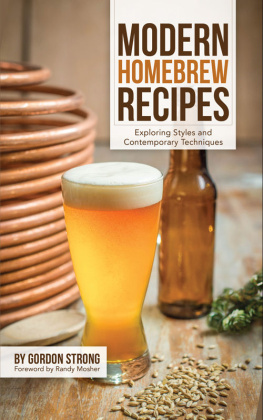THE
ULTIMATE GUIDE TO
HOMEBREWING
TECHNIQUES AND RECIPES TO GET BREWING TODAY
THE EDITORS OF THE HARVARD COMMON PRESS

CHAPTER 1
THE BASICS OF BREWING
Brewers use only four ingredients to make a basic beer: water, barley, hops, and yeast. Each part is irreplaceable and essential to the process, so understanding its role and what it brings teaches you how to modify, tweak, and use the ingredients to create nearly any beer, wild or mild, you can dream up.
INGREDIENTS
WATER
Water constitutes 90 to 95 percent of a beer, so always use a clean source for brewing. Most tap water is acceptable as long as its run through a carbon filter prior to brewing. Advanced brewers learn to adjust their water to suit their beer.
MALT
Malted grains bring color, aroma, and flavor to a beer, but most importantly, they are the fuel for creating alcohol. Malt houses let grains such as barley and wheat germinate and begin to grow, creating starch. Then, they dry the grains and stop the process, leaving a large amount of starch. The majority of any beer will use a pale malt (called base malt). Darker beer adds specialty grains that are roasted to different temperatures and impart various flavors and color.
New brewers often use liquid or dried malt extract to simplify the brewing process. This provides the same maltose (sugar) grains impart for brewing. While extracts are just as fermentable, their flavors can be inconsistent and lack the subtlety and complexity of true barley or wheat.

HOPS
These dried green flowers contribute bitterness, aroma, and flavor to a beer. A 5-gallon (19 L) batch of homebrew might need only an ounce (28 g) of dried hop pellets to balance a sweeter amber ale, while a hop-centric India pale ale could use up to 8 ounces (225 g) or more.
YEAST
This microorganism is the engine behind beer. It consumes sugar derived from the malt starch to make alcohol. There are hundreds of different brewing yeast strains, each working at different temperatures and producing varying flavors. German wheat beers (hefeweizens), for example, owe much of their spicy character to their specialized yeast.
UNDERSTANDING GRAVITY, CALCULATING ABV
When the sugars from your mash dissolve into the hot water, the liquid (your wort) becomes denser. As yeast ferments that sugar out, converting it to alcohol, the beer becomes less dense. By subtracting the second, third, or final gravity reading from the first, and then accounting for the density of alcohol (multiply by 1.31), you can easily calculate a beers alcohol content. Starting gravityfinal gravity x 1.31 x 100 = alcohol by volume
SUPPLIES
These are the supplies necessary to brew beer from grain to glass like a pro. Beginners should feel no shame in skipping the mash and lauter by adding malt extract to the kettle, but these are the tools of the trade for homebrewers ready to emulate their favorite brewmasters.
MASH TUN
Your crushed grains and hot water are combined in the mash tun to produce sugar during the first step of homebrewing. The two most common options are insulated coolers and metal mash kettles. Coolers, like the ones in which you would store beer at a party, hold the mash at a constant temperature with minimal work, but its difficult to raise the mash temperature if needed. Mash kettles are heavy-duty pots, usually fitted with a spigot and false bottom for lautering.
LAUTER TUN
Often the mash and lauter tun are the same thing. A lauter tun is a large container with a screen or false bottom under the grains that allows the wort to drain out.
BREW KETTLE
Any large metal stock pot will docopper, stainless steel, or aluminumas long as its big enough. Your brew kettle should have 1 to 2 gallons (3.8 to 7.6 L) more capacity than the liquid in it. Extract brewers use 5-gallon (19 L) pots, and all-grain brewers use at least 7-gallon (26.7 L) pots.
WORT CHILLERS
These copper or stainless coils have an inlet (and outlet) for tap water to run through the coil. When placed in hot wort, the water-cooled coil quickly drops the wort temperature.
FERMENTOR
Brewers need a primary fermentor, usually a food-grade plastic bucket, and then a secondary fermentor, typically a glass carboy for aging. The bucket is easy to use and clean, but it is also porous, letting small amounts of oxygen in, making it a bad candidate for aging beer.
BOTTLING BUCKET
This plastic bucket with a spigot allows you to mix your beer with priming sugar and then easily dispense into bottles.
CAPPER
This simple device crimps bottle caps and seals your beer.
AUTOSIPHON
Its not a necessity, but this makes transferring beer from one container to another a breeze.
HYDROMETER AND REFRACTOMETER
These devices will tell you how much sugar is in your beer, indicating how much can be fermented, and later, how much has been fermented out.
A COMMERCIAL BREWERY BREW DECK MAY LOOK ENDLESSLY COMPLICATED BUT FOLLOWS NEARLY ALL THE SAME PROCESSES AS A 5-GALLON (19 L) HOMEBREWERY.
THE BREWING PROCESS: AN OVERVIEW
Brewing is a simple process thats easily complicated. And this book assumes a basic understanding of the principles that turn barley starch and hop flowers into pale ales and porters. These steps provide a basic reference for the steps to reach a finished (and delicious) beer, but for a more in-depth look at brewing fundamentals, read Charlie Papazians The Complete Joy of Homebrewing and John Palmers How to Brew.

1. MASH AND LAUTER THE GRAINS
The first step on the road to homebrewing is mashing the malted grains. You need sugar to ferment beer, and this is where you create it. The mash is a mixture of crushed grains and hot water that converts the starch in barley, wheat, or other grains into sugar (which yeast will turn into alcohol). Barley has two enzymes (proteins that encourage chemical reactions) that break starch down into sugar when theyre within particular temperature ranges. Homebrewers typically mix their grains with hot water and hold their mash between 145F and 158F (63C and 70C) for at least 20 minutes.
2. LAUTER
Once enzymes have converted most of the starch to sugar, drain the liquid out in a process called lautering. Add additional hot water (around 170F [77C]) to help flush out the sugar. The first couple gallons (liters) of liquid drained out should be gently poured back over the grains. Water clarity should improve, and small bits of husk will stop coming out. This recirculation creates a filter to keep grain out of the wort. In total, you should have 5.5 to 6 gallons (20.9 to 22.7 L) of wort to create a 5-gallon (19 L) batch of beer.















